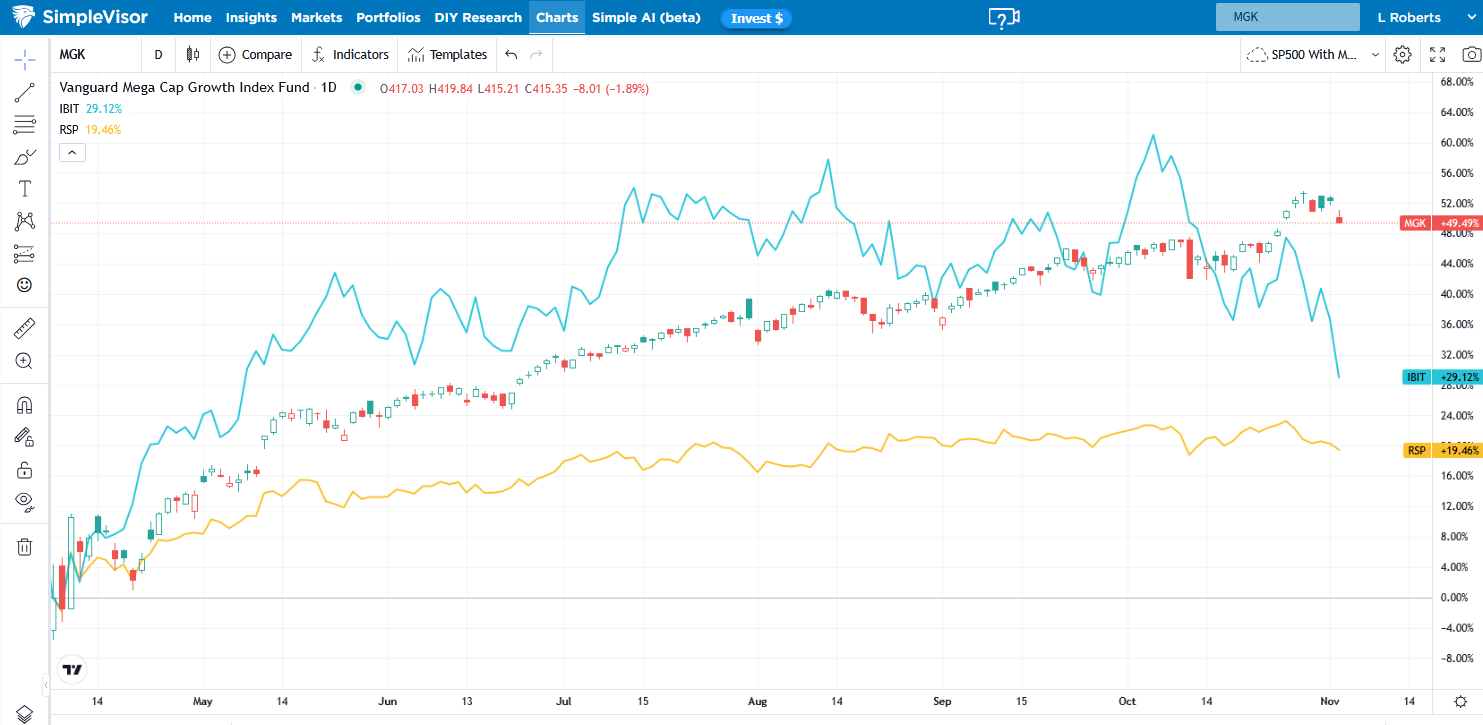SharkNinja shares soar 11% as third quarter results crush expectations
On many recent occasions, we have noted that the market breadth is poor and appears to be worsening. By worsening, we mean that the number of market leaders is declining, and a growing number of stocks, stock factors, sectors, and asset classes are lagging.
Currently, the small list of stock factors showing up in as overbought relative to the market is S&P 500 Growth (NYSE:IVW), Mega Cap Growth (NYSE:MGK), High Beta (NYSE:SPHB), and Disruptive Technology (ARKK). As the breadth has narrowed, one notable asset class has dropped off the leaderboard. Bitcoin and other cryptocurrencies have significantly underperformed the S&P 500 over the past four to six weeks.
The graph below compares the recent performance of Bitcoin, Mega Cap Growth (MGK), and the Equal Weight S&P 500 (RSP). As it shows, Mega Cap stocks continue to trend higher, up almost 50% since the Liberation Day trough. Bitcoin accelerated even faster from the April lows, rising 60% in early October.
However, over the past month, Bitcoin and other cryptocurrencies have fallen sharply, giving up about half of the April-to-October gains. It now stands about 20% below MGK since April. For context, we show RSP representing all of the stock sectors and factors that have been lagging. While its 19% gain since April is nice, its underperformance is striking.
Bitcoin is another victim of the narrowing of market leadership. The thinning of the leadership as speculative assets like Bitcoin fall by the wayside ultimately points to a rotation to the large majority of stocks that have not kept up with the broader indexes and the high-flying tech stocks.
ISM Manufacturing
With the government shutdown over a month old, the market has been starved of economic data. We have noted occasionally that, despite the government shutdown and missing data, there are other sources for essential data. One of these is the Institute for Supply Management (ISM) survey of manufacturing and service sector companies. On Monday, the manufacturing survey was released.
Survey results differ from most other economic data reports. In the ISM, for instance, the survey questions generally ask whether a particular facet of the business is better, worse, or the same. It doesn’t account for the absolute change in conditions. For instance, someone may answer that prices were higher this month than last month. But the answer doesn’t inform us how much higher. With that in mind, we share a few details from the ISM Manufacturing survey:
- ISM- 48.7 vs 49.1 last month.
- New Orders- These are a good forward-looking indicator. For October, the new orders index rose by 0.5 to 49.4. A reading below 50 signals that more companies surveyed expect new orders to shrink than to rise. While still in contraction, the increase is promising.
- Employment- At 46.0, employment is also contracting. While a pickup from last month, the index signals that a majority of those surveyed are laying off employees rather than net hiring.
- Prices- The good news is that the prices index fell 3.9 to 58. While still rising, the number of respondents reporting higher prices versus lower prices is settling back toward a neutral 50.
Generally, the report points to economic contraction, as it has for three years, but shows some internal signs of improvement. It’s worth noting that the service sector accounts for a much larger share of the economy than manufacturing.
Tweet of the Day

